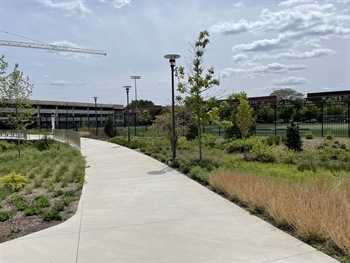StormStore is helping value the multiple benefits that Green Infrastructure delivers to the Chicago region. The trick is understanding which parts can be valued, how to conduct a replicable valuation, and where to find a buyer or buyer that value those benefits.

Ryan Wilson/MPC
Communities and developers across the Chicago region are building a significant amount of Green Stormwater Infrastructure (Green Infrastructure, or GSI). It is worth considering the full value GSI practices can bring to communities—to promote their expanded use, plan and budget for ongoing maintenance, and more. Some communities may also have the opportunity to participate in StormStore™, a partnership between the Metropolitan Planning Council and The Nature Conservancy that is supporting the development of a stormwater credit trading marketplace in the Chicago region.
Valuing GSI projects requires understanding their primary benefits and “co-benefits." Read on for a breakdown of these benefits and how to measure their value.
Identifying the Benefits of Green Stormwater Infrastructure
Two primary benefits of GSI practices are reducing stormwater runoff and improving water quality. Depending upon design, some GSI practices also might increase the volume of available surfacewater or improve the recharge of groundwater. Either way, GSI practices primarily help communities manage surface stormwater and reduce the risk of local flooding.
Green infrastructure may also generate a range of secondary benefits, often referred to as community benefits, or "co-benefits." These co-benefits—such as improving the environment, economy, or public health—can accrue at the site or neighborhood scale.
Depending upon their design, GSI practices can provide a number of co-benefits to communities’ local environment. Landscaped GSI improvements, such as rain gardens, planters, and bioswales, can provide habitat for native plants and pollinators, increasing biodiversity and species richness. This type of vegetation also helps to improve air quality by filtering airborne pollutants and moderating the local microclimate, relieving some of the urban heat island effect. In turn, nearby buildings may not need to be cooled as much during the warmer months. Larger landscaped features may also serve as greenways, or naturalized pathways, for species migrating through urban areas.
GSI that allows stormwater to infiltrate into the ground also may reduce carbon emissions from treatment facilities that otherwise would be needed to treat stormwater runoff. Landscaped improvements that use plants for bioretention also can sequester carbon.
GSI practices also can provide a number of economic benefits to communities. By improving the environment and aesthetics of a community, GSI practices can increase the area’s land values, which in turn may generate higher property tax revenues. Constructing and maintaining GSI practices also generates jobs. Larger GSI practices, such as constructed wetlands, can provide recreational opportunities if incorporated into their design.
As previously mentioned, landscaped GSI improvements can improve the air quality, moderate the microclimate, and improve the water quality of a community. All of these co-benefits can have a positive effect on the community’s public health, as well as the addition of quality greenspace. Numerous studies have shown that having more and better quality greenspace in a community is associated with better mental and physical health outcomes for residents by creating outlets to reduce fatigue and stress. Some studies have even noted how proximity to greenspace is associated with improved public safety in terms of lowered narcotics use and reduced criminal activity.

Ryan Wilson/MPC
Valuing the Benefits of Green Stormwater Infrastructure
There are numerous methodologies that communities can use to value the benefits and co-benefits provided by GSI practices. Some of these benefits and co-benefits can be expressed in monetary terms. For instance, harvested stormwater has a monetary value and could be bought and sold as a product.
Alternatively, communities could value various benefits and co-benefits by estimating the costs that GSI practices help communities to avoid paying. For instance, any GSI practice that diverts stormwater from a community’s drainage system saves the community from having to pay to treat that runoff.
Similarly, if a community had to replace the benefits and co-benefits that GSI practices provide through some other means, it would incur a replacement cost to do so. A community could also estimate the costs it would incur to restore or mitigate against the loss of the benefits and co-benefits their GSI practices provide. These methods indicate the monetary value that a community derives from GSI practices, and the benefits and co-benefits received.
In addition, communities could use hedonic pricing models to determine the effect GSI practices have had on nearby property values. A hedonic model considers the intrinsic and extrinsic factors that effect a property's value. A community could hire a reseacher to independently measure the effect of GSI practices' benefits and co-benefits on property values in a given area, to achieve an overall value.
Because many GSI practices provide communities with “non-market” (i.e., not tradeable) goods and services, it is not always possible to monetize their value. This means that communities might need to use more subjective methods to value their GSI practices.
For example, communities could disseminate a survey or conduct focus groups asking respondents to value various benefits or co-benefits. When using these methods, communities should ask respondents about their willingness to pay (WTP) for various benefits or co-benefits, or about their willingness to accept (WTA) the loss of those benefits or co-benefits. WTP and WTA indicate how residents’ value these benefits and co-benefits.
Understanding the value of GSI in your community is useful for a number of reasons. If you want to expand this practice, knowing the value of existing GSI can help make the case for future investments. Likewise, maintaining GSI requires ongoing investment, which may require annual budgeting decisions. Finally, as the region explores the potential for a stormwater credit trading through StormStore, knowing the value of existing and potential GSI practices in your community can help determine your opportunity to participate in this burgeoning marketplace.